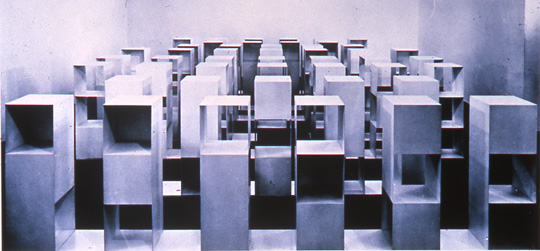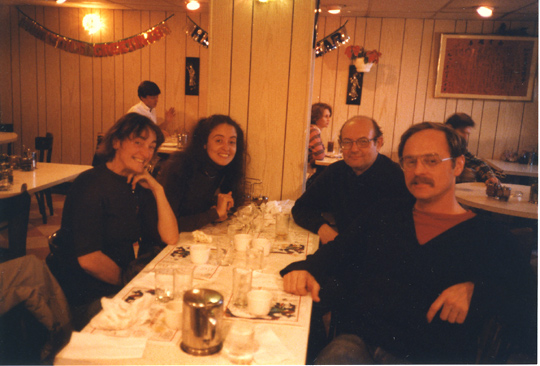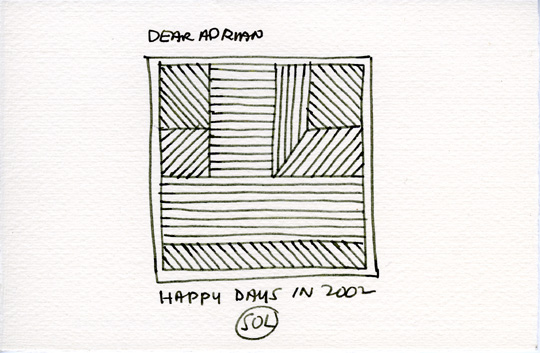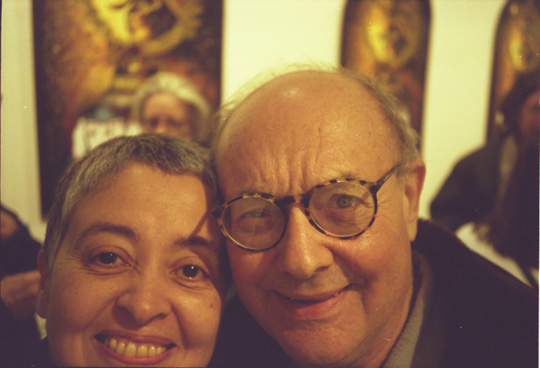Now that the sun has gone down permanently, it is time for those of us
who knew him to bask reflectively in the memory of its rays, as Sol
never allowed us to do while he was alive, so that others who were
not thus privileged will also understand what we all have lost.
Since no superlatives would be adequate to express the magnitude of
this loss, I simply describe here the way in which I knew Sol, and who
he was for me. Maybe if all of his friends do this, we will gradually,
collaboratively sculpt a complete picture of him out of all of our
partial ones, a celebration of all the known permutations of Solhood.
And maybe Sol would be okay with this, if he understood it as an
expression not only of our love but of our grief. He was above all
a compassionate man.

Sol LeWitt, 46 Variations on Three Different Kinds of Cubes (1967)
Sol showed 46 Variations on Three Different Kinds of Cubes at the Dwan Gallery in 1967, while I was a student at the School of Visual Arts. It opened my mind, and revolutionized my practice as an artist. By presenting an ordered series of objects as exemplars of a personal but highly logical system of permutations, Sol demonstrated the potentially infinite number of ways in which reality could manifest. I remember as vividly as if it were yesterday the power of those austere white, four-foot high square columns of steel cubes, stacked in threes and set in rows of six, advancing toward me in direct frontal formation, each shaded slightly differently from the next, all displaying simultaneously the rigor of system and the playfulness of idiosyncrasy, filling the space with their authority. They radiated presence, significance, and also mystery, because the conceptual scheme they embodied was not perceptually obvious. In order to understand why these physical structures expressed meaning and order so intensely yet so privately, you had to be willing to study them, compare them, count them, organize them in thought; to think, to research, to consider carefully the unlimited variety of ways in which even the simplest object could have been slightly different than it was. Sol expressed this wonder at the infinite variability of the geometrical foundations of perception throughout all of his work, up to the very end. He conferred meaning and conceptual significance on the individual objects he fashioned through their relationship, not to the critical analysis of a third-personal viewer, but rather to the conceptual system that he as an artist also fashioned. Sol proved that we could be artists and theorists at the same time.
Rosalind Krauss wrote a long, unenthusiastic review of this groundbreaking show in Artforum. I didn’t have the nerve to just call him up and console him; I knew who he was, but we’d never met. But I did write him a letter of consolation about how much I’d liked the show and how important I thought it was. I suggested that he ignore the review. He wrote back, thanking me and remarking that he didn’t mind if the review was negative, as long as it was lengthy. He also enclosed two working drawings from the series, and suggested that we meet at the Bykert Gallery and go for a beer. We both arrived around the same time. Apparently he’d been expecting a man, because when I walked up to him, he did a double take and asked, “You’re Adrian Piper?” I assured him that I was, and we went for our beer. Both Virgos, both lovers of Bach and Beckett, we bonded right away, while bickering about whether or not Bach’s choral works (Sol’s preference) were superior to his instrumentals works (my preference at the time). Actually I didn’t know Bach’s choral works that well – I owe my love of them to Sol; but felt pleased that he pulled no punches in defending them and promised to reconsider The Art of Fugue, if I would reread the works of Beckett I’d failed to fully appreciate, which were most of them. Sol was not as verbose as I’m making him sound. He was shy, and sparing with words, which he used plainly and to great effect. He asked for nothing but my friendship, and I asked for nothing but his.

Lucy Lippard,
Adrian Piper, Sol LeWitt, Jerry Kearns
(December 1982; photograph by Jeffrey Evans)
Actually that is not true. I became a complete pest after he got me a loft in his building at 117 Hester St. He and his partner, Mary Peacock (and later Mimi Wheeler), enjoyed having friends over, so I became a frequent guest at his dinners, which also included Bob Ryman, Lucy Lippard, Carl Andre and Rosemary Castoro, Bob and Sylvia Mangold, Bob Smithson and Nancy Holt, Mel Bochner and Dorothea Rockburne, Hans Haacke, Don Judd, Hanne Darboven, Joseph Kosuth and Christine Koslov, Dan Graham and Lee Lozano, Jan Dibbets, Larry and Susan Wiener, Doug Huebler, John Weber, Virginia Dwan, Konrad Fischer, Kaspar König, Nicholas Logsdail, and others. Sol and I had quickly realized that we were almost exactly twenty years apart in age, so he held several joint birthday dinners in his loft during the years we both lived at Hester St. I was a bad cook, but sometimes helped with the dishes. I also borrowed all of his books by Beckett and all of his Bach recordings, and watched so many old movies on his TV that in desperation he bought me one for my 20th birthday, and brought a chair upstairs for me to sit in so I could watch it. I also fed his cat, Puss, while he was away, and executed some of his drawings. In return for my being a pest and feeding his cat, and without my knowledge, he chatted up my work to all of his friends in the art world. I have no idea how many doors he opened for me. But I received invitations to show my work in all of the Conceptual art exhibitions that were then taking place in Europe, and unsolicited visits from gallerists, critics and curators from all over the world who knew him. Sometimes he would have such a person to lunch or dinner downstairs, and urge them to drop upstairs to see my work while they were there. In large measure I owe my easy admission into the art world, and my early success, to him.
He was puzzled by the direction my work took in the early ‘70s, awed by my Ph.D. in Philosophy from Harvard (not immediately recognizing either as the natural consequence of his artistic and intellectual influence on me), and astonished to learn I was African American. But he trusted me, trusted my judgment and trusted the value of my work. No later revelations changed that. We kept in touch after I left New York and he left the U.S. to live in Spoleto with Carol.

Sol LeWitt, New Year’s Day Card(2002)
Once he returned to the U.S. to live, we met infrequently, but whenever we could. When the complete Teldec edition of Bach came out on CD, he offered to tape each one for me. By then I’d realized the magnitude of what he’d already done for me, so I refused.
When the Paula Cooper Gallery ran a show of mine in the Fall of 2000, Sol and I hadn’t actually seen each other in years. I had just gotten out of the hospital and couldn’t be at the opening, so Paula arranged a closing party in January 2001, and Sol made a special trip into the city to be there. At that late date it was no longer possible for me to be oblivious to what it meant that he had extended himself in this way. I wanted to hug him for a long time, but didn’t dare. He didn’t pretend to know yogic philosophy, but he got the application of seriation and aleatoric decision-making methods to the various colors of people’s skins. I was grateful for that. He said I was turning people’s races into stacked cubes. I said he had turned stacked cubes into people.

Adrian Piper, I Am Some Body, The Body Of My Friends: Sol LeWitt (2001; color photograph)
The last time I saw him was in 2004, at his house in Chester, which Carol had made beautiful, comfortable and inviting for him and everyone who loved him. He’d fought off the cancer once, and looked well and rested. He was surrounded by his books, his music, his art, his friends and his family. He was blissfully happy, and I felt healed and warmed by being near him. We visited his archive, which housed not only his own work but also his collection. I saw his studio, full of images and memories I remembered from Hester St., and noted that among his snapshots he kept a photo of my mother, because, he said, she was beautiful. I saw how happy Carol had made him. I saw how happy it made him to banter with Eva, and marveled at his ability to regard her and Sofie with both fatherly love and respect for their budding independence. I saw that this was a man who genuinely liked and respected women. He spoke of going swimming later that day. As I pulled out of his driveway, I noticed how impressed he was that I’d learned to drive. As I said goodbye to him, we both agreed that we would meet again soon.
I always wanted to be just like Sol – a real gentleman: strong, calm, kind,
modest, soft-spoken; unassuming but unflappable, generous, honest,
forthright, good through and through. He was not just lucky, but blessed,
for his kindness to others was repaid with love, and that enabled him to be
who he was, fully, for all of us who were privileged to circle in his
orbit. One of the reasons he was so averse to all the encomia his friends
tried to arrange or publish during his lifetime was his personal modesty:
He did not want it suggested that he had an orbit, or that we were drawing
light and inspiration from his presence. But we were; and in that we, too,
were blessed.
© Adrian Piper Research Archive 2007